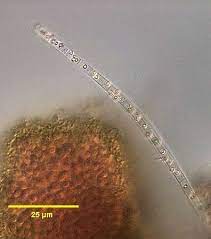Beggiatoa alba
Classification
Domain: bacteria; Phylum: Pseudomonadota; Class: Gammaproteobacteria; Order: Thiotrichales; family: Beggiatoaceae
Description and Significance
Description: Strains of colorless, filamentous, gliding bacteria, visible to the naked eye, exhibit great diversity in size.
Size: Ranging from about 3.0 to 5.0 μm in diameter
Importance: Due to its ability to detoxify sulfide, this microbe plays a huge role in the sulfur cycle of coastal environments.
Genome Structure
There is little to no information on this specific species genome due to not being completely mapped out.
Cell Structure and Metabolism
Interesting features of cell structure?: The colorless cells are disk-shaped or cylindrical, arranged in long filaments with a cell diameter that can measure between 12 and 160 micrometers. contains a massive central vacuole. the filaments are surrounded by slime, giving them the ability to glide. The cell wall consists of five discrete layers external to the cytoplasmic membrane, the surface layer contains linear arranged longitudinal fibrils ranging from 10 to 12 nm in diameter, and thin sections of sulfur inclusions have 12 to 14 nm thick pentalaminar envelope.
metabolism: Beggiatoa alba's metabolism of sulfide, sulfur, and acetate was studied in both oxic and anoxic environments. With the stoichiometric reduction of oxygen to water, B. alba oxidized acetate to carbon dioxide. Sulfide and other traditional respiratory inhibitors, including dibromo thymoquinone, inhibited in vitro acetate oxidation.
Ecology
Ecology: just like other Beggiatoa spp. Beggiatoa alba is ubiquitous, forming giant mats in microoxic zones of freshwater, brackish, and marine sediments living in temperatures ranging from tropic to arctic levels. Filaments have been observed to form dense mats on sediments in estuarine, shelf, seep, and deep-sea hydrothermal vent environments appearing as a whitish layer.
Habitat: Lives at the oxic/anoxic interface of aquatic habitats in high concentrations of sulfide reaching toxic levels. these environments include cold seeps, sulfur springs, sewage-contaminated water, mud layers of lakes, deep hydrothermal vents, and many others.
References
Podstawka A. Beggiatoa alba B15LD | DSM 1416 | BacDiveID:17076. bacdive.dsmz.de. Accessed November 16, 2022. https://bacdive.dsmz.de/strain/17076
Mezzino MJ, Strohl W, Larkin J. Characterization of Beggiatoa alba. undefined. Published online 2004. Accessed November 16, 2022. https://www.semanticscholar.org/paper/Characterization-of-Beggiatoa-alba-Mezzino-Strohl/c6f470bf4da5dcdf0770942b05ff3b24160e7c20
Mueller J. Beggiatoa alba B18LD, A Ubiquitous Sulfide-detoxifying Gamma-proteobacterium. Grantome. Published September 2008. Accessed November 16, 2022. https://grantome.com/grant/NSF/EF-0827186
Strohl, William & HOWARD, K. & LARKIN, J.. (1982). Ultrastructure of Beggiatoa alba Strain B15LD. Microbiology-sgm. 128. 73-84. 10.1099/00221287-128-1-73.
Methylotrophy and nitrogen metabolism in Beggiatoa strains - ProQuest. (n.d.). Www.proquest.com. Retrieved December 2, 2022, from https://www.proquest.com/openview/56156c3b0e842f81a5a3f3ba153e646c/1?pq-origsite=gscholar&cbl=18750
Beggiatoa - Alchetron, The Free Social Encyclopedia. (2017, August 18). Alchetron.com. https://alchetron.com/Beggiatoa#Metabolism
Schmidt, T.M. et al. (1987) Sulfur metabolism in Beggiatoa Alba, Journal of bacteriology. U.S. National Library of Medicine. Available at: https://www.ncbi.nlm.nih.gov/pmc/articles/PMC213973/ (Accessed: December 12, 2022).
Author
Page authored by _Jakell Corbett_, student of Prof. Bradley Tolar at UNC Wilmington.

